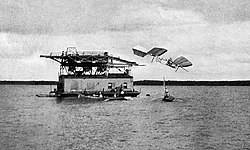Langley Aerodrome (aircraft)
| Langley Aerodrome | |
|---|---|
 |
|
| First failure of the manned Aerodrome, October 7, 1903 | |
| Role | Experimental, pioneer fixed-wing aircraft |
| National origin | United States |
| Designer | Samuel Langley |
The Langley Aerodrome was a pioneering but unsuccessful manned, powered flying machine designed at the close of the 19th century by Smithsonian Institution Secretary Samuel Langley. The U.S. Army paid $50,000 for the project in 1898 after Langley's successful flights with small-scale unmanned models two years earlier.
Langley coined the word "Aerodrome" and applied it to a series of engine-driven unmanned and manned tandem wing aircraft that were built under his supervision by Smithsonian staff in the 1890s and early 1900s. The term is derived from Greek words meaning "air runner".
After a series of unsuccessful tests beginning in 1894, Langley's unmanned steam-driven model "number 5" made a successful 90-second flight of over half a mile at about 25 miles (40 km) per hour at a height of 80 feet (24 m) to 100 feet (30 m) on May 6, 1896. In November model "number six" flew almost 1 mile (1.6 km). Both aircraft were launched by catapult from a houseboat in the Potomac River near Quantico, Virginia, south of Washington, D.C. The flights impressed Assistant Secretary of the Navy Theodore Roosevelt enough for him to assert that "the machine has worked" and to call in March 1898 for the United States Navy to create a four-officer board to study the utility of Langley's "flying machine," the first documented U.S. Navy expression of interest in aviation.
The full-scale Aerodrome, financed by the United States War Department and carrying Langley's chief assistant Charles M. Manly, was launched the same way on October 7 and December 8, 1903. On both attempts the Aerodrome failed to fly and crashed into the Potomac River seconds after launch. Manly was pulled unhurt from the water each time. Nine days after the December 8 failure, the Wright Brothers flew into history with their four successful flights near Kitty Hawk, North Carolina. The Aerodrome's internal combustion engine generated 53 horsepower, about four times that of the Wright brothers' gasoline engine of 1903. However, Langley had not properly appreciated the problems of calculating stress on an airframe or controlling an aircraft, and the Aerodrome broke up on launch. Langley made no further tests, and his experiments became the object of scorn in newspapers and the U.S. Congress.
...
Wikipedia
